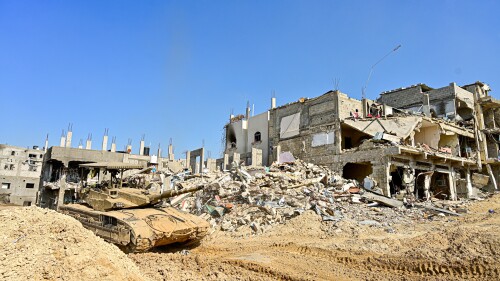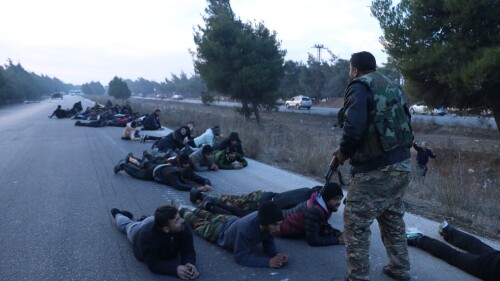On Sunday, January 28, three US service personnel from the US Army Reserve’s 718 Engineer Company were killed at the Tower 22 outpost on the Jordan-Syrian border. An additional 34 soldiers were wounded, some suffering traumatic brain injuries. The dead are Sgt. William Jerome Rivers, 46, of Carrollton, Georgia; Spc. Kennedy Ladon Sanders, 24, of Waycross, Georgia; and Spc. Breonna Alexsondria Moffett, 23, of Savannah, Georgia.
More than 160 operations against US forces in Iraq and Syria have been carried out since October 7. The January 28 drone attack on Tower 22 was the first of these to cause fatalities. Whoever carried out the attack transformed, with a single stroke, the campaign in Iraq and Syria from an arena that the US administration could plausibly depict as a sideshow or irritant in the broader current picture of Middle East turmoil, into the central focus of that picture. Pro- and anti-US forces in the region are now watching to see how the US will respond.
But who exactly carried out this attack?
Who Is Targeting U.S. Forces in Iraq and Syria?
The body that since October 2023 has claimed responsibility for the bulk of the attacks calls itself the Islamic Resistance in Iraq (IRI). A Telegram channel called “war media” (al-elam al-harbi) carries messages from this “organization.”
An Arabic language statement on this channel issued on January 29 took responsibility for the attack on Tower 22 (without mentioning the outpost by name). The statement read:
In continuation of our approach to resisting the American occupation forces in Iraq and the region, and in response to the Zionist entity’s massacres against our people in Gaza, the Mujahideen of the Islamic Resistance in Iraq attacked at dawn today, Sunday, January 28, 2024, using drones, four enemy bases, three of which are in Syria. (Al-Shaddadi base, al-Rukban base, and al-Tanf base), and the fourth is inside the occupied Palestinian territories, which is the Zevulun naval facility.
The Islamic Resistance confirms that it will continue to destroy enemy strongholds.
More than 160 operations against US forces in Iraq and Syria have been carried out since October 7. The January 28 drone attack on Tower 22 was the first of these to cause fatalities.
The Islamic Resistance in Iraq, however, is considered by all analysts of Iraq to constitute a convenient catch-all name for Iran-associated Shi’ite militias, rather than a specific group. The use by the Iraqi militias of generic titles of this kind is in keeping with the long standing “facade” strategy of these militias, by which they seek to avoid retribution for violent anti-US actions.
This stance is necessary for them because, in addition to carrying out insurgency against the US, the militias in their political form constitute part of the government of Iraq. They need to ensure continued access to the US financial system for their front groups.
So who are the most significant groups within this umbrella structure?
Iran’s Islamic Revolutionary Guards Corps (IRGC) maintains multiple militia structures on Iraqi soil, each with its own specific history and orientation. These range from large, well-organized, and bureaucratic bodies like the Badr Organization, to smaller, semi-clandestine groups such as Asaib Ahl al-Haq.
The pattern of US responses to the attacks so far, however, and close observation of the claims of responsibility, point to two mid-sized Iraqi Shi’ite militia groups as the main suspects in the Tower 22 attack. The two groups are Ktaeb Hezbollah, currently led by Abu Fadak al Mohammadawi, and Hezbollah al-Nujabaa, led by Akram al-Kaabi.
A study by the Washington Institute for Near East Policy noted that the organization that took responsibility for some of the first attacks after October 7, Tashkil al-Waritheen, was a name used in the past as a “facade” by Nujabaa. The Washington Institute report also observed that Tashkil al-Waritheen’s claim of responsibility for an October 17 drone attack on an airbase in Iraqi Kurdistan was removed after Islamic Resistance in Iraq made a subsequent statement that it was responsible for the attack. Such evidence suggests Nujabaa’s involvement under the banner of IRI.
The Islamic Resistance in Iraq, however, is considered by all analysts of Iraq to constitute a convenient catch-all name for Iran-associated Shi’ite militias, rather than a specific group.
Ktaeb Hezbollah, meanwhile, has notably been the target of US sanctions and direct military responses since October 7. The al-Asad airbase in Iraq, where US personnel are present and that has been attacked several times, is within the geographical area of operations usually associated with this group.
On November 17, the US announced new sanctions on six people associated with the organization. On December 26 and on January 24, US aircraft struck at facilities belonging to Ktaeb Hezbollah following attacks on al-Asad. On January 30, the organization suddenly announced a cessation of operations against the US. It is presumably aware of coming US retribution for the January 28 killings and wants to portray these as aggression.
So either Ktaeb Hezbollah or Nujabaa most likely carried out the attack on Tower 22. And of the two, given its more high-profile role in attacking US targets both prior to and following October 7, my guess is that Ktaeb Hezbollah is the more likely perpetrator.
Of course, whether Nujabaa or Ktaeb carried out the attack, there is a level of responsibility above that of the Iraqi Shi’ite militias. Both these groups are instruments of the IRGC’s Quds Force, which in turn is an organ of the Islamic Republic of Iran.
Neither organization makes any effort to hide these affiliations. In the summer of 2015, I embedded for a short while with Ktaeb Hezbollah’s forces in Iraq’s Anbar Province. They were engaged against the Islamic State at the time. The fighters and junior commanders I interviewed were all perfectly open about the movement’s connections to Iran. (In an amusing incident, they thought I was an Iranian when I first arrived at their base.)
When I interviewed the movement’s founder and leader, Abu Mahdi al-Muhandis, a few days later, (and five years before he was killed in the same attack that targeted QF commander Qasem Soleimani) I expected that a figure of this level of seniority would be more coy regarding his movement’s dependency on Iran.
He was not. Ktaeb Hezbollah and other Shi’ite militias relied on “capacities and capabilities provided by the Islamic Republic of Iran,” Abu Mahdi told me, as we talked at a dusty militia base outside the oil town of al-Baiji.
Of course, whether Nujabaa or Ktaeb carried out the attack, there is a level of responsibility above that of the Iraqi Shi’ite militias. Both these groups are instruments of the IRGC’s Quds Force, which in turn is an organ of the Islamic Republic of Iran.
Even then, Ktaeb Hezbollah did not look like the rag-tag Sunni Arab and Kurdish militias operating in the same period in Syria and Iraq. All the fighters wore uniforms and had centrally-issued weapons. There was a clear hierarchy of command and a high level of fitness and tactical proficiency. Ktaeb Hezbollah – as its leader did not deny – was very obviously the product of the capacities that only a state can provide.
Teheran, however, is currently indignantly denying any connection to the militias attacking US forces in Syria and Iraq. Iranian permanent representative to the United Nations, Amir Saeed Iravani, in a letter to the president of the UN Security Council, wrote this week that “there is no group affiliated with the Iranian Armed Forces, whether in Iraq, Syria or anywhere else, that is under the direct or indirect control of Iran or acts on its behalf. Therefore, Iran is not responsible for the actions of any individual or group in the region.
Given the weight of evidence pointing to IRGC proxy militias as the perpetrators of the attack that took the lives of three US soldiers this week, Amir Iravani’s denial appears absurd.
It remains to be seen whether the US will choose to notice this absurdity, with the resulting requirements of action if it does, or whether it will continue to indulge it. Either way, the US soldiers Rivers, Sanders, and Moffett were killed, on January 28, by forces in the direct employ of the Islamic Republic of Iran.








